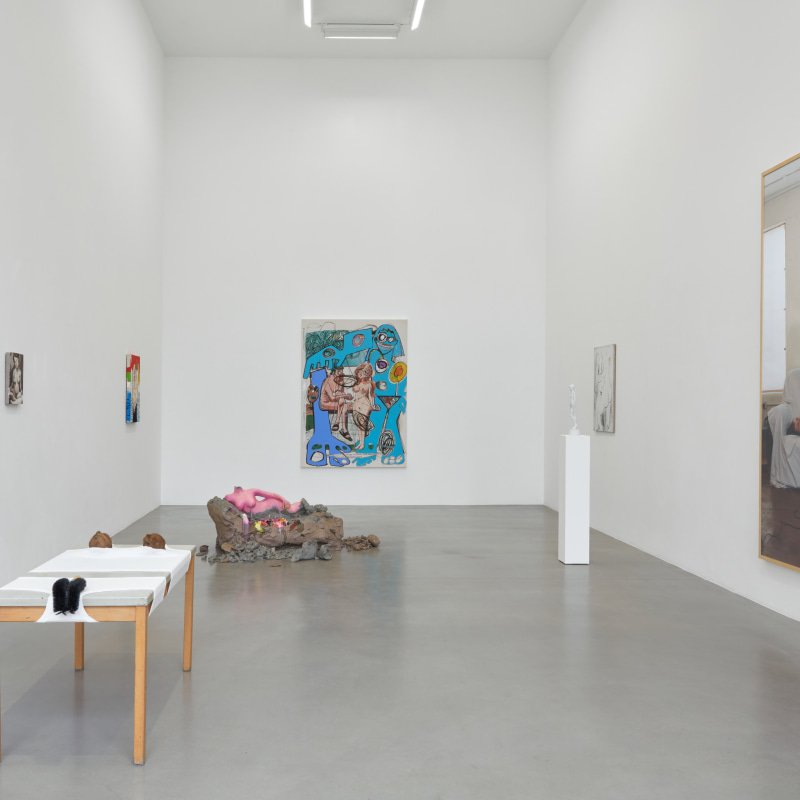In spring 2018, Sadie Coles HQ presents Nudes, an exhibition focusing on the nude body in sculpture, painting and photography. Works by thirteen artists, spanning five decades, examine the versatile and paradoxical power of the nude body, whether as an ancient motif or a mirror of contemporary attitudes. The body passes through different shades of meaning – idealised, erotic, comic and vulnerable.
Many of the works in Nudes deconstruct the traditional opposition between the ‘naked’ and the ‘nude’ – that of defensive exposure versus the confidence of the nude body. Frank Benson’s Human Statue (Bronze) (2009), a hyper-real replication of a bronze-painted street performer, straddles both registers. The double bluff of a ‘human statue’ – life masquerading as art – twists back on itself. A similar conflation of classical and everyday resonances is discernible in Don Brown’s porcelain statuette Yoko XXXVI (2013), in which the ‘pure’ white medium and swivelling pose are offset by the individualizing details of Yoko’s hairstyle and platform shoes. In a new painting by Borna Sammak, Pool Party (2018), executed in heat-press vinyl and embroidery, the dignity of the nude comically evaporates: an undressed man urinates before a backdrop of cut-out scenery.
In several cases, the nude carries narrative associations. In William N. Copley’s La Paloma (1972), a naked woman (rendered in curving outlines and planes of colour) dances beside a window while a white dove flies up to her breast – anticipating the dynamic movement and erotic charge of Laura Owens’s painting Untitled (2012). Angus Fairhurst’s Pietà (1996) transposes the nude body of the artist into an absurdist recreation of the biblical scene. Naked and playing dead in the hands of a lifeless costume, Fairhurst constructs a self-portrait that is knowingly staged (the cable release for the camera can be seen trailing from his hand) yet disarmingly raw.
The recurring formula of the reclining female nude is reprised and subverted in works by Sarah Lucas and Urs Fischer. In Lucas’s Nude No. I (1999), coconuts, underwear and a scrubbing brush are spread across a table to represent a prostrate female body – crude slang made comically literal. Fischer’s 4 (2014) is a bronze cast of a female body modelled in clay. Headless, rough-hewn and doused in bright pink, the figure transmutes into a cartoonish object sprawled across a chaise longue. The nude as cartoon – and as a symbol of clichéd gender dynamics – is also the subject of Richard Prince’s Free Love #93 (2015) in which a dated Playboy cartoon is engulfed by one of Prince’s own ‘hippie drawings’.
In a number of works by female artists of female subjects, the unclothed body constitutes an exploration of selfhood. Elizabeth Peyton’s Alice Neel 1931 (2007-8) represents Neel in an unguarded, contemplative moment. Painted from a black-and-white photograph, it is both a portrait and an oblique self-portrait: through the act of transcription, Peyton alludes to her own act of looking and reimagining. Upstairs, Nicola Tyson’s Self-Portrait: Early 80’s (1995) imagines the artist’s body in a transitional state – half-undressed, face averted, Paloma Varga Weisz’s Lying Woman (2016) transforms the nude into a shelf-top figurine, whose bumped and chiselled topography evokes the artist’s origins as a woodcarver.
In the upstairs gallery are three sculptures from Ugo Rondinone’s nude series of 2011. The life-size wax figures were cast from the bodies of dancers to create a set of differently-posed ‘variations’, each composed from joined sections. Despite the crisp realism of their surfaces, the casts’ dark pigmentation and the repeating ‘x’ signs of their titles universalize and abstract the models: nude bodies become symbols of naked emotion.
For further information please contact the gallery at +44 (0)20 7493 8611 or press@sadiecoles.com
